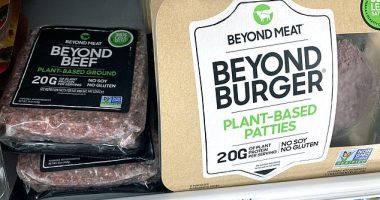To discover what those potential dietary don’ts are—and what tyramine is to begin with—we consulted Dani Lebovitz, MS, RDN, a food education expert and the founder of Kid Food Explorers based in Franklin, Tennessee.
Experts In This Article
What is tyramine?
“Tyramine, a natural substance in our bodies, helps manage blood pressure and brain signals,” Lebovitz explains. Deriving from the amino acid tyrosine, it’s also found in common foods and drinks. (It’s in the same chemical group as the neurotransmitters dopamine, norepinephrine, and serotonin.)
While tyramine has an important job in your body, things can get risky if you take monoamine oxidase inhibitors (MAOIs), a class of medications used to treat depression and anxiety. MAOIs help regulate mood by blocking monoamine oxidase, an enzyme that removes neurotransmitters like serotonin, dopamine, and norepinephrine (stuff you need for stable mood levels) from your brain. But MAOIs also prevent the breakdown of excess tyramine in the body—because remember, tyramine is related to those neurotransmitters.
Unless you suspect or know for sure that tyramine is a trigger for you, there’s no need to cut high-tyramine foods out of your diet.
Having a surplus of tyramine can lead to headaches, chest pain, and blurred vision, as well as blood pressure spikes that may require immediate medical attention. Those taking MAOIs may avoid certain foods1, and same goes for people prone to migraines. And while tyramine intake may be included in that, experts caution against making dietary changes without consulting a trained dietitian or physician. “It’s all about how your body processes tyramine,” she explains. “Cutting back on foods high in it can make a big difference in managing these conditions.” But there are no guarantees, so speak with your healthcare provider about tyramine-rich foods before you forego red wine or ramen without reason.
What foods contain tyramine?
Speaking of which: Lots of foods contain tyramine, but fermented or aged foods and drinks tend to have the most tyramine. That’s because microbes convert tyrosine (the amino acid) into tyramine as the foods age2. So the more “aged” or fermented something is, the more likely it is to have lots of tyramine.
Foods high in tyramine
Lebovitz says that the following foods are typically very high in tyramine:
- Aged cheese (such as Parmesan, Swiss, Stilton, and Gorgonzola)
- Dry-cured meats (like salami or pepperoni)
- Pickled foods (like kimchi, sauerkraut, or pickles)
- Salt-dried seafood
- Liver
- Certain beans (like Haricot beans)
- Fish sauce
- Soybeans, tofu, and other soybean products
- Miso
Alcohol is also high in tyramine thanks to its methods of production. “Alcoholic drinks like beer—especially draught and craft beers—along with red wines are known for their high tyramine levels,” Lebovitz says.
If you’re trying to avoid high-tyramine foods and drinks, Lebovitz says you might want to cut back on coffee because the effect of too much caffeine (like headaches and a racing heartbeat) can mimic those of tyramine. “Therefore, individuals sensitive to tyramine may also benefit from moderating their caffeine intake,” she says.
“Alcoholic drinks like beer—especially draught and craft beers—along with red wines are known for their high tyramine levels,” Lebovitz says.
Low-tyramine foods
If you and your healthcare team find that you could benefit from a low-tyramine diet, there’s no shortage of healthy foods to enjoy. Per Lebovitz, they include the following:
- Fruits: Apples, pears, strawberries, blueberries, peaches, plums, and bananas that aren’t overripe
- Vegetables: Leafy greens, carrots, tomatoes, potato, zucchini, and turnips
- Dairy: fresh milk, yogurt, and non-fermented cheeses such as cream cheese, cottage cheese, and ricotta
- Protein: fresh meats, fish, poultry, eggs, beans, canned legumes (excluding fava and broad beans)
- Whole grains: rice, pasta, and bread
As a general rule of thumb, Lebovitz says you can succeed in following a low-tyramine diet by eating the foods above in a prompt manner and paying attention to how they’re stored and prepared. “For fresh produce, consume it within a couple of days of purchase. For canned or frozen foods, use them soon after opening, too,” she advises. When it comes to fresh animal proteins, she suggests eating or freezing them the same day of purchase.
Should everyone limit tyramine?
No, not everyone needs to stress about tyramine. Some people may need to take extra care to limit their intake of tyramine foods based on their health conditions and medications. Others may be more sensitive to it than others, and some people may process it just fine. Unless you suspect or know for sure that tyramine is a trigger for you, there’s no need to cut high-tyramine foods out of your diet.
It’s always best to consult your health-care provider before making any major changes to your diet—especially if you’re managing medical conditions. “If you think you may have a tyramine sensitivity, keeping a food log can be a helpful tool to identify patterns and potential triggers,” Lebovitz shares. “Meeting with a dietitian [who can] offer personalized guidance may also be helpful.”
Well+Good articles reference scientific, reliable, recent, robust studies to back up the information we share. You can trust us along your wellness journey.
- Van den Eynde, Vincent et al. “The Prescriber’s Guide to the MAOI Diet-Thinking Through Tyramine Troubles.” Psychopharmacology bulletin vol. 52,2 (2022): 73-116.
- Anderegg, Janine et al. “Effects of Sodium Chloride on Tyramine Production in a Fermented Food Model and its Inhibition by Tyrosine-degrading Lactobacillus plantarum JA-1199.” Chimia vol. 74,5 (2020): 391-397. doi:10.2533/chimia.2020.391
Source: Well and Good





